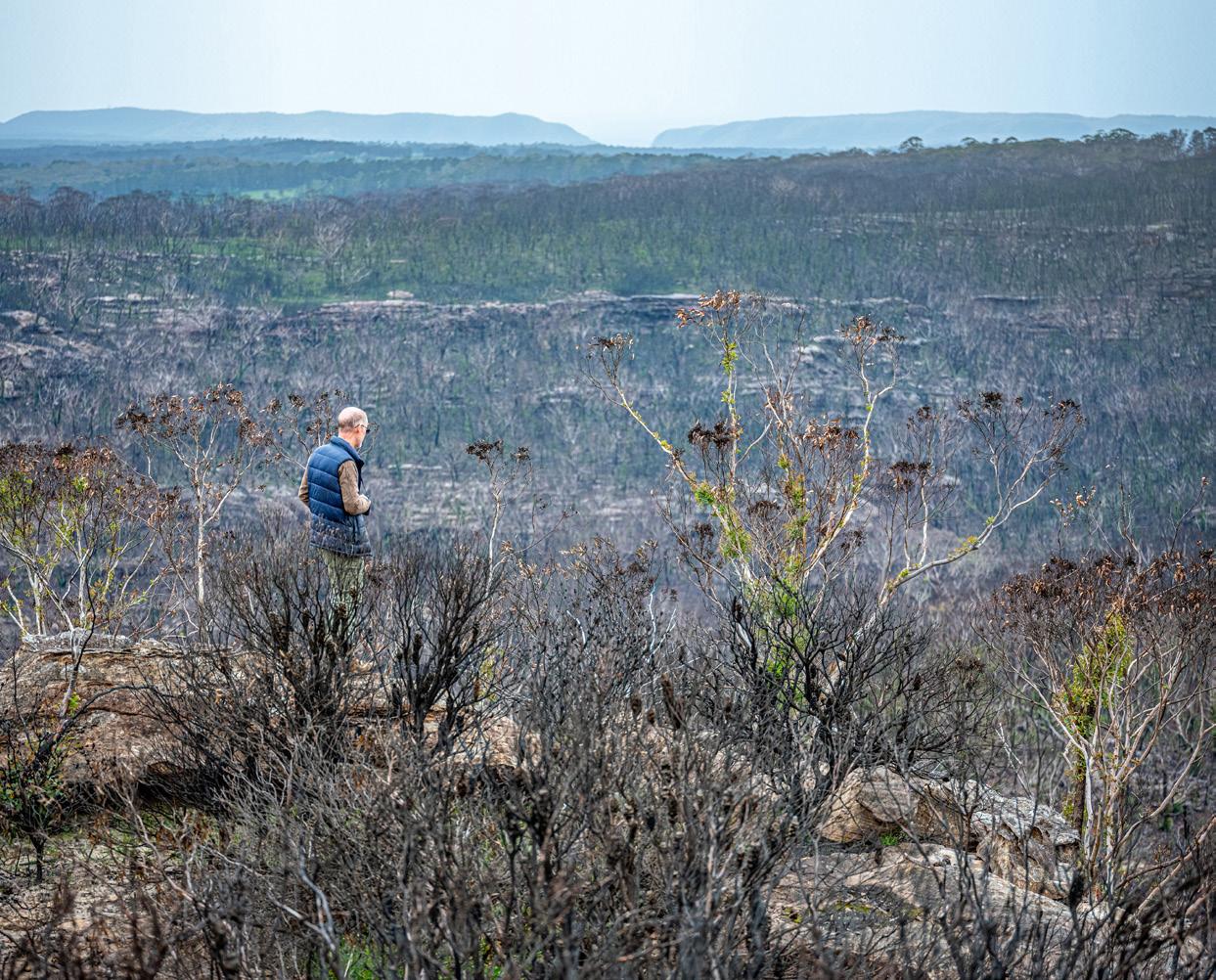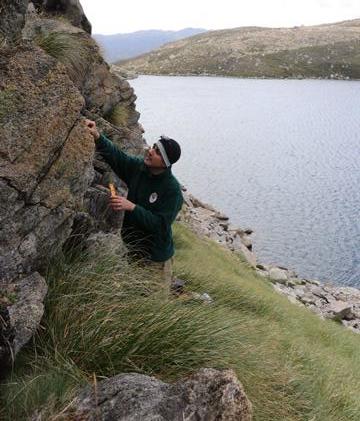
6 minute read
The Australian Institute of Botanical
Brett Summerell at the conservation area at the Blue Mountains Botanic Garden
Mount Tomah after recent bushfires
Advertisement
THE AUSTRALIAN INSTITUTE OF BOTANICAL SCIENCE
A NEW STATE-OF-THE-ART FACILITY BEING CONSTRUCTED AT THE AUSTRALIAN BOTANIC GARDEN MOUNT ANNAN WILL BE A VITAL HUB FOR THE DIVERSE LIVING AND VIRTUAL RESOURCES OF ALL THREE BOTANIC GARDENS
The past six months or so have had a huge impact on the natural world, especially plants. Bushfires across millions of hectares of bushland have seen billions of trees, shrubs and other plant life go up in flames. Some plants will survive, some will be lost, and some will thrive in response to the fire. Species respond in different ways, requiring different levels of support to ensure their survival.
Make no mistake, these fires that followed one of the worst droughts this country has experienced, have been exacerbated by climate change. These catastrophic events will become more frequent and intense, based on the consensus of scientific projections from research groups worldwide. Given
that, we need to be pre-emptive and ready to ensure the survival of Australia’s unique plant life.
This scenario, coupled with the opportunities provided by the new National Herbarium of NSW being constructed at the Australian Botanic Garden Mount Annan, highlight the national and international importance of the Botanic Gardens’ science and education programs through the establishment of the new Australian Institute of Botanical Science.
Jessica Wait hand-pollinating Prasophyllum bagoense on Bago Plateau in the Snowy Mountains

A SCIENTIFIC COLLABORATION The Australian Institute of Botanical Science consists of the physical and virtual scientific collections, services and facilities at the Royal Botanic Garden Sydney, Australian Botanic Garden Mount Annan and the Blue Mountains Botanic Garden Mount Tomah. Following are the various components of the Institute.
Science has always been at the core of the Royal Botanic Garden’s activities, with it being Australia’s oldest scientific organisation. In the earliest days of Sydney, its role was to develop and establish economic industries and enterprises based on plants, then in the 20th century the focus shifted to documenting the flora of New South Wales and Australia. Now, with many plants under threat of extinction, there is an urgent impetus to ensure species are safeguarded. In its various guises, the Garden and its scientists have made substantial and prolonged contributions to documenting, understanding and protecting plant life in Australia.
As a result of our current extinction crisis, we must amplify our activities in botanical science, plant conservation and community education, and prepare the next generation of researchers to ensure the survival of plants, and all forms of life that depend on them.
Gavin Phillips collecting Carex archeri specimens at Blue Lake in Kosciuszko National Park

National Herbarium of NSW The Herbarium is one of the most significant botanical resources in the Southern Hemisphere, housing more than 1.43 million plant specimens. Scientists regularly discover, document and classify plants and algae, and seek to understand their relationships and evolution. We explore ecosystems to document what is there and discover new species, and there are still many to be found. Every year, more than 8000 botanical specimens are added to the Herbarium collection, which is essential for informing and making decisions about the conservation and management of our natural environment. Every specimen is also being captured as a high-resolution image. By the time the collection is moved to the Herbarium’s new location at the Australian Botanic Garden Mount Annan, every single specimen will be fully accessible online.
Australian PlantBank Located at the Australian Botanic Garden Mount Annan, PlantBank is the award-winning home of plant conservation research, germplasm collection and storage in New South Wales. Its seed and tissue culture collections provide an insurance policy against extinction of native plants in the wild. Approximately half the nearly 5000 species of plants found in New South Wales are stored in PlantBank’s seed vault, and about 67 per cent of threatened species from across the state have been carefully collected and are stored here.
Research Centre for Ecosystem Resilience Based at the Royal Botanic Garden Sydney, the new Research Centre for Ecosystem Resilience (ReCER) will provide evidence-based information for restoring, repairing and protecting native ecosystems confronted by climate change, degradation and invasive species. It will include the flagship Restore & Renew project, with programs on the genetics of threatened species, as well as diseases affecting plants in gardens, parks and our natural environments, which will provide information to help habitats.

Living Collections The Living Collections at the Royal Botanic Garden Sydney, the Blue Mountains Botanic Garden Mount Tomah and the Australian Botanic Garden Mount Annan each contain a scientific resource of wild-sourced living plant material of known provenance for use in a range of scientific endeavours. The Gardens’ nurseries and propagation facilities are critical in the production of plants for use in supplementing at-risk plant populations in the wild. It is likely that these living collections contain plants that could be used to develop bush foods, new plants for horticulture and new medicines. The Gardens will be working with partners to explore this potential in the future.
Daniel Solander Library Established in 1852, the Daniel Solander Library, located in the Royal Botanic Garden Sydney, is the oldest botanical research library in Australia. Its world-class collections contain more than 250,000 items, including materials as diverse as books, journals, maps, manuscripts, historic photographs, botanical illustrations, archives, archaeological artefacts and memorabilia, covering the areas of science, history and culture.

The Connections Garden at the Australian Botanic
Garden Mount Annan
Centre for Learning and Engagement The Gardens’ scientific programs support education and outreach for the whole community, especially those targeted at STEM (science, technology, engineering and maths) programs for school-aged children. Through curriculumaligned or formal programs and informal programs, the Centre for Learning and Engagement provides transformative learning experiences, which help to grow people’s connections, curiosity and understanding of nature, STEM, culture and community. The Centre connects higher education programs, science communication and outreach, to highlight the importance of plants in our lives.
SUSTAINING LIFE The Gardens’ research programs are focused on themes that centre around the importance of plants in our lives, and the need to conserve and protect them for everyone’s benefit.
They focus on the need to provide a knowledge hub for Australian and New South Wales flora, documenting and describing new plants across the environment, conserving and protecting threatened species, and supporting and establishing resilient ecosystems, whether they be in the bush or in urban environments. The new Australian Institute of Botanical Science will serve this purpose.
Plants are central to the existence of all life on our planet, and they are under threat now in a way that has never before been experienced. It is imperative, now more than ever, for the Australian Institute of Botanical Science to be established, and there is so much work to be done. Your support is hugely appreciated! Dr Brett Summerell
HOW YOU CAN HELP To support your Gardens, visit botanicalscience.org.au/donate, call Foundation & Friends on (02) 9231 8182 or email foundation.friends@rbgsyd. nsw.gov.au. Thank you.










